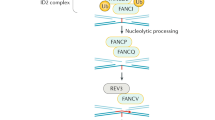Abstract
Whole blood from two mentally retarded fra-X brothers was grown in low folate medium where fra-X expression was enhanced. Bromodeoxyuridine was added to mitigate the low folate conditions and metaphases were sampled sequentially, and stained for replication banding, through one cell cycle of recovery. — The replication bands allowed detailed analysis of the cell cycle and the allocation of individual cells to precise sub-phases. Various classes of fra-X and all other types of chromosomal aberrations were scored in these classified cells. — The fra-X does not conform in morphology to any of the known simple chromatid intrachange types, which were often present within the same cells, but the subsequent fall in frequency once bromodeoxyuridine was added closely paralleled that of the conventional aberrations. — Normal folate level frequencies of fra-X are restored by the time early S-phase cells (subphase SkI) reach metaphase. When sub-phased cells are rearranged in true chronological sequence, there is a suggestion of a sudden fall in frequency between SkII–III (about 70% of the transit of S). This suggests that the critical point for low folate enhancement occurs in this region of the S-phase. This is somewhat earlier than the band-appearance distribution curve for Xq27 which lies within subphase SkIV.
Similar content being viewed by others
References
Bender MA, Griggs MG, Walker PL (1973) Mechanisms of chromosomal aberration production. I. Aberration induction by ultraviolet light. Mutat Res 20:387–402
Brogger A (1977) Non-random localization of chromosome damage in human cells and targets for clastogenic action. Chromosomes Today 6:297–306
Cawood AH (1981) Chromosome replication in fibroblasts of the Syrian hamster (Mesocricetus auratus). Chromosoma 83:711–720
Cawood AH, Savage JRK (1983) A comparison of the use of bromodeoxyuridine and [3H]thymidine in studies of the cell cycle. Cell Tissue Kinet 16:51–57
Darlington CD, La Cour LF (1945) Chromosome breakage and the nucleic acid cycle. J Genet 46:180–267
Duncan AMV (1986) Enhanced sensitivity of lymphoblastoid cells from individuals carrying the mutation for the fragile X syndrome to the clastogenic effects of FUdR. Mutat Res 173:201–205
Dutrillaux B, Couturier J, Richer CL, Viegas-Péguignot E (1976) Sequence of replication in 277 R- and Q-bands of human chromosomes using a BrdU treatment. Chromosoma 58:51–61
Glover TW (1981) FUdR induction of the X chromosome fragile site: Evidence for the mechanism of folic acid and thymidine inhibition. Am J Hum Genet 33:234–242
Howard-Peebles PN, Howell WH (1981) Behaviour of chromosome cores at heritable fragile sites: 16q 22 and Xq 27. Cytogenet Cell Genet 31:115–119
Kihlman BA (1966) Deoxyribonucleotide synthesis and chromosome breakage. Chromosomes Today 1:108–117
Kihlman BA (1971) Molecular mechanisms of chromosome breakage and rejoining. Adv Cell Mol Biol 1:59–107
Li X, Reidy JA, Wheeler VA, Chen ATL (1986) Folic acid and chromosome breakage. III. Types and frequencies of spontaneous chromosome aberrations in proliferating lymphocytes. Mutat Res 173:131–134
Savage JRK (1976) Annotation: classification and relationships of induced chromosomal structural changes. J Med Genet 13:103–122
Savage JRK, Prasad R (1984) Cytological subdivision of the S phase of human cells in asynchronous culture. J Med Genet 21:204–212
Savage JRK, Prasad R, Papworth DG (1984) Subdivision of S-phase and its use for comparative purposes in cultured human cells. J Theor Biol 111:355–367
Sutherland GR (1979) Heritable fragile sites on human chromosomes. I. Factors affecting expression in lymphocyte cultures. Am J Hum Genet 31:125–135
Sutherland GR (1983) The fragile X chromosome. Int Rev Cytol 81:107–143
Tommerup N, Poulsen H, Brodum-Nielsen K (1981) 5-Fluoro-21 deoxyuridine induction of the fragile site on Xq28 associated with X linked mental retardation. J Med Genet 18:374–376
Yunis JJ, Soreng AL, Bowe AE (1987) Fragile sites are targets of diverse mutagens and carcinogens. Oncogene 1:59–69
Author information
Authors and Affiliations
Rights and permissions
About this article
Cite this article
Savage, J.R.K., Fitchett, M. The behaviour of fragile X and other aberrations during recovery from low folate conditions. Chromosoma 96, 391–396 (1988). https://doi.org/10.1007/BF00330707
Received:
Revised:
Issue Date:
DOI: https://doi.org/10.1007/BF00330707




